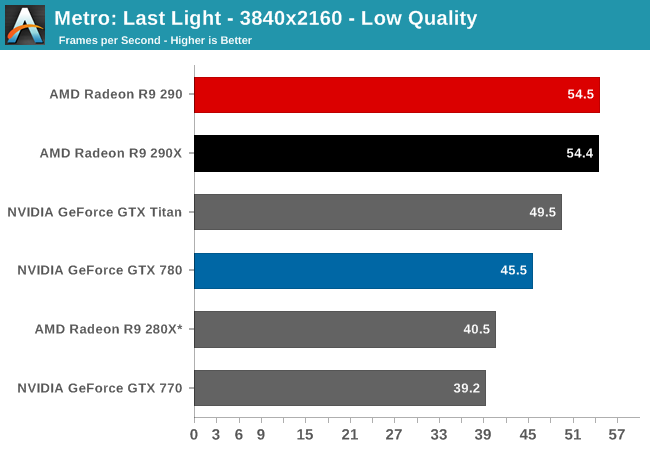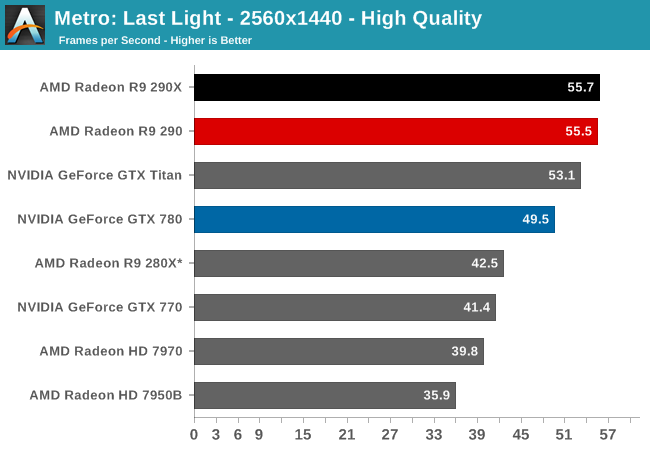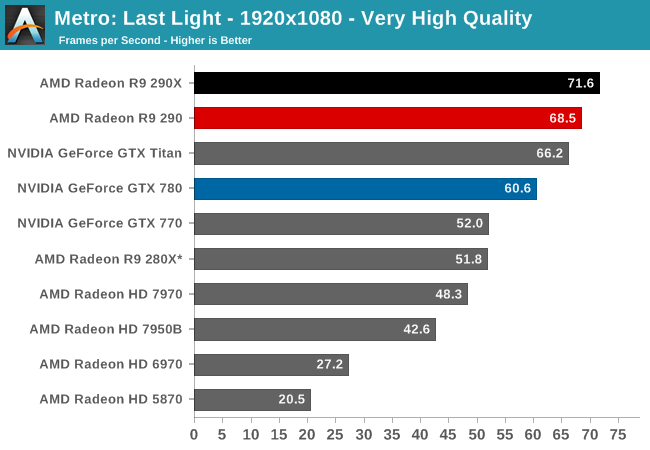The AMD Radeon R9 290 Review
by Ryan Smith on November 5, 2013 12:01 AM EST- Posted in
- GPUs
- AMD
- Radeon
- Hawaii
- Radeon 200
Metro: Last Light
As always, kicking off our look at performance is 4A Games’ latest entry in their Metro series of subterranean shooters, Metro: Last Light. The original Metro: 2033 was a graphically punishing game for its time and Metro: Last Light is in its own right too. On the other hand it scales well with resolution and quality settings, so it’s still playable on lower end hardware.



For the bulk of our analysis we’re going to be focusing on our 2560x1440 results, as monitors at this resolution will be what we expect the 290 to be primarily used with. A single 290 may have the horsepower to drive 4K in at least some situations, but given the current costs of 4K monitors that’s going to be a much different usage scenario. The significant quality tradeoff for making 4K playable on a single card means that it makes far more sense to double up on GPUs, given the fact that even a pair of 290Xs would still be a fraction of the cost of a 4K, 60Hz monitor.
With that said, there are a couple of things that should be immediately obvious when looking at the performance of the 290.
- It’s incredibly fast for the price.
- Its performance is at times extremely close to the 290X
To get right to the point, because of AMD’s fan speed modification the 290 doesn’t throttle in any of our games, not even Metro or Crysis 3. The 290X in comparison sees significant throttling in both of those games, and as a result once fully warmed up the 290X is operating at clockspeeds well below its 1000MHz boost clock, or even the 290’s 947MHz boost clock. As a result rather than having a 5% clockspeed deficit as the official specs for these cards would indicate, the 290 for all intents and purposes clocks higher than the 290X. Which means that its clockspeed advantage is now offsetting the loss of shader/texturing performance due to the CU reduction, while providing a clockspeed greater than the 290X for the equally configured front-end and back-end. In practice this means that 290 has over 100% of 290X’s ROP/geometry performance, 100% of the memory bandwidth, and at least 91% of the shading performance.
So in games where we’re not significantly shader bound, and Metro at 2560 appears to be one such case, the 290 can trade blows with the 290X despite its inherent disadvantage. Now as we’ll see this is not going to be the case in every game, as not every game GPU bound in the same manner and not every game throttles on the 290X by the same degree, but it sets up a very interesting performance scenario. By pushing the 290 this hard, and by throwing any noise considerations out the window, AMD has created a card that can not only threaten the GTX 780, but can threaten the 290X too. As we’ll see by the end of our benchmarks, the 290 is only going to trail the 290X by an average of 3% at 2560x1440.
Anyhow, looking at Metro it’s a very strong start for the 290. At 55.5fps it’s essentially tied with the 290X and 12% ahead of the GTX 780. Or to make a comparison against the cards it’s actually priced closer to, the 290 is 34% faster than the GTX 770 and 31% faster than the 280X. AMD’s performance advantage will come crashing down once we revisit the power and noise aspects of the card, but looking at raw performance it’s going to look very good for the 290.










295 Comments
View All Comments
nushydude - Tuesday, November 5, 2013 - link
The gap between the 290 and 290x seems to shrink when you go up the resolution. Does that mean the cards are held back by the memory? If not, what could be the reason for this behavior?Ryan Smith - Tuesday, November 5, 2013 - link
At those resolutions they're more likely to be held back by ROP throughput. Keep in mind that both cards have 64 ROPs, and that the 290 is on average clocked higher than the 290X. So the 290 actually has at least marginally greater ROP throughput than 290X.nushydude - Tuesday, November 5, 2013 - link
I cannot imagine how fast the 290 and 290x would be with proper cooling.TheJian - Tuesday, November 5, 2013 - link
About as fast as the many overclocks around the web show. :) Not much faster than that. If by proper you just mean a better fan/heatsink set up. I don't call water proper. If that's what it takes to run "proper" you need to redesign your chip.With 780 vs. 290x overclocked to max they could get 780 won every benchmark:
https://www.youtube.com/watch?v=djvZaHHU4I8
Both ref designs, benchmarks at 8:40 or so, so proper cooling won't change much I don't think. You will just get less noise or heat, they already run max at 1075 OC'ed as they show here in the 290 review even. You might end up tied or something with 780 (assuming an OC'ed card with better fan gets 5-10% better) but it's not going to blow your mind and a NON ref fan would get more on 780 over what linustechtips vid shows also.
"Similarly we didn’t encounter any throttling issues with our overclocked settings, with every game (including CoH2) running at 1075MHz sustained."
Above from the OC page in this review. It was never throttled and nobody on the web hit higher than 1125 in a review so you're not going to get much more than anandtech did without maybe water or something.
Guru3D OC: 1075/6000
Hardwarecanucks OC: 1115/5684
Hardwareheaven OC: 1100/5500
PCPerspective OC: 1100/5000
TweakTown OC: 1065/5252
TechpowerUp OC: 1125/6300
Techspot OC: 1090/6400
Bit-tech OC: 1120/5600
I can't remember if they mention how high they got the clock in the linustechtips unboxing video above but you can assume they landed somewhere in the group above.
ddriver - Tuesday, November 5, 2013 - link
Amazing performance and value from AMD. This seems just like the GPU for me, since my PC sits in the "server" closet and cables are routed through the wall to my room. Also, amazing compute performance, which is mostly what I need, I might be getting this to replace my aging 470.cartmanasan - Tuesday, November 5, 2013 - link
"To get right to the point then, this [Windforce, DCU2 et.al] is one of a handful of cards we will wholeheartedly recommend. The performance for the price is stunning, ..." - Ryanshodanshok - Tuesday, November 5, 2013 - link
Hi Ryan,the review is generally very well done, and I 100% agree with you the at 150$ price difference, the 290 is basically eating into 290X terrirory.
However, the 290X is clearly an super-enthusiast product, headed to an audience that rarely will not overclock the card (replacing its cooler, maybe with a water block). For this audience, loud/power are rarely of any real concern. So we should consider that, while 290 is very near to 290X, the latter has its "uber mode" to be used. Moreover, as the 290X has a lower voltage, and so an higher efficiency, raising the fan speed even above the 47% threshold should give higher performance boost in respect to the 290. HardOCP did a test with a 290X and a >60% fan speed, and performance was quite higher the "normal" uber mode.
Moreover, while I agree that "loud limit" is a personal affair (and my limit is quite low!), it seems that AMD cooler has a not-so-disturbing pitch. To quote another review:
"Subjectively speaking, there are much more annoying coolers in this territory on the decibel meter. The impressively smooth, gradual ramp of fan speeds up and down in the new PowerTune algorithm helps make the noise less noticeable, too. This ain't an FX-5800 Ultra, folks."
Had you the possibility to hear, side-by-side, the new 290 against, say, a 5870? What was more disturbing? It will be fantastic if you can post a wav/mp3 file recorder at normal distance and closed case...
Anyway, as my "GPU performance ego days" are very far away, I think that Nvidia solution retain some strong appeal to silence-lover.
Thank you and regards.
Ryan Smith - Tuesday, November 5, 2013 - link
"Had you the possibility to hear, side-by-side, the new 290 against, say, a 5870? What was more disturbing?"We've benchmarked both of those cards of course. The 290 is without a doubt subjectively louder, which the hard data backs up.
Per Hansson - Tuesday, November 5, 2013 - link
Some constructive critisism: You can't measure the power of the whole computer and then run a full page on how the 290 draws more power than the 290X.That can be down to any number of things, like the CPU load being higher because of the different VGA load or the computer just deciding to do something in the background, which the later Windows releases loves to.
Techpowerup isolates the card when measuring power, their numbers are here: http://www.techpowerup.com/reviews/AMD/R9_290/24.h...
Load GPU voltage for the 290X measured at a coil is 1.14v, for the 290 it is 1.17v, so very similar to your card but entirely different power consumption numbers.
faster - Tuesday, November 5, 2013 - link
This review makes me appreciate what a value the 280X is. At $300 it performs admirably in games at 1920 x 1080 where the majority of gamers reside. It has much lower noise than the 290 (46 - 50 under load) and temperatures less than the GTX 770 under load. $100 price differential between the 280x and the 290 is not insubstantial to a budget gamer. The 33% increase in price from the 280x to the 290 is rewarded with a 20% increase in performance (approximately). The 280X is the sweet spot for a budget gamer.AMD's competition with Nvidia is an awesome thing for the consumer. Too bad they can't challenge Intel more. I would like to see Intel cut their extreme edition chips down from $1000 because AMD released a killer alternative.